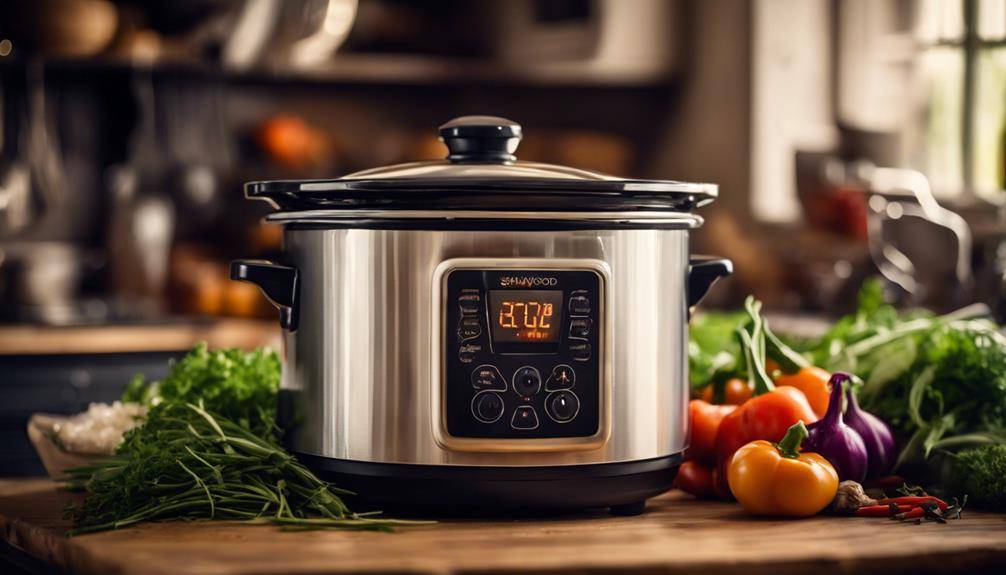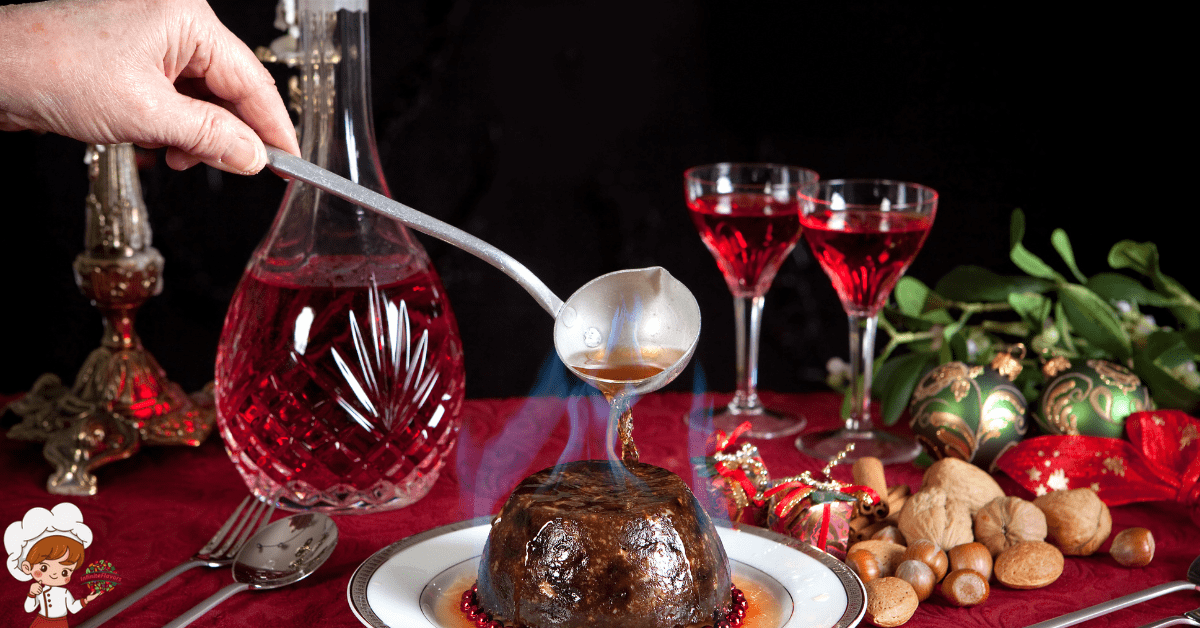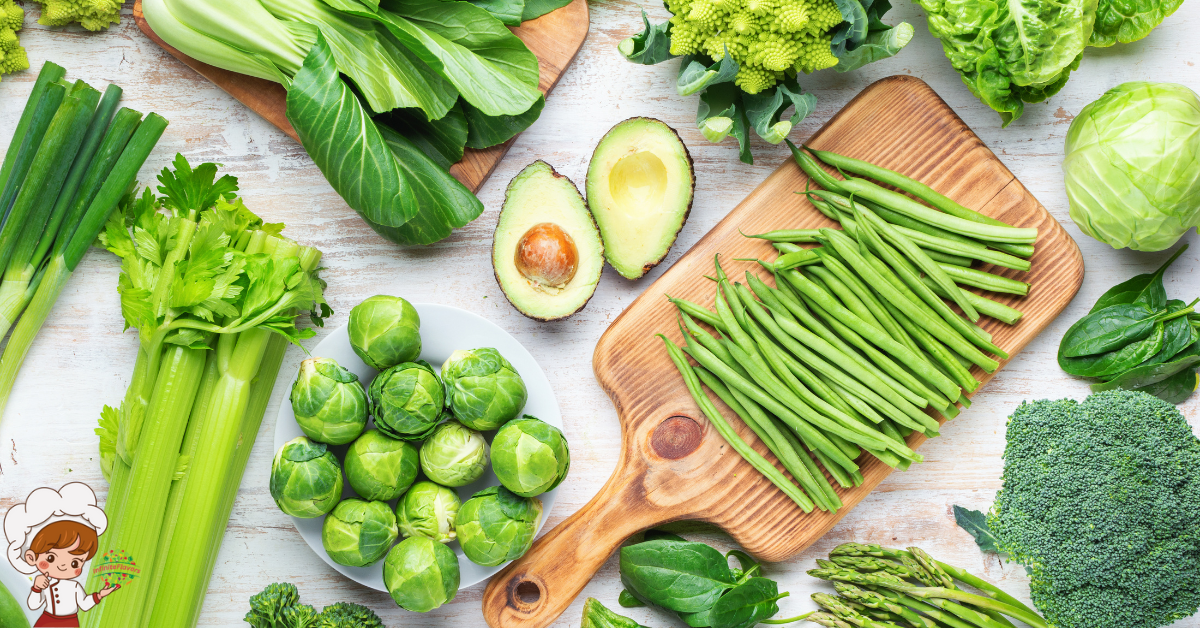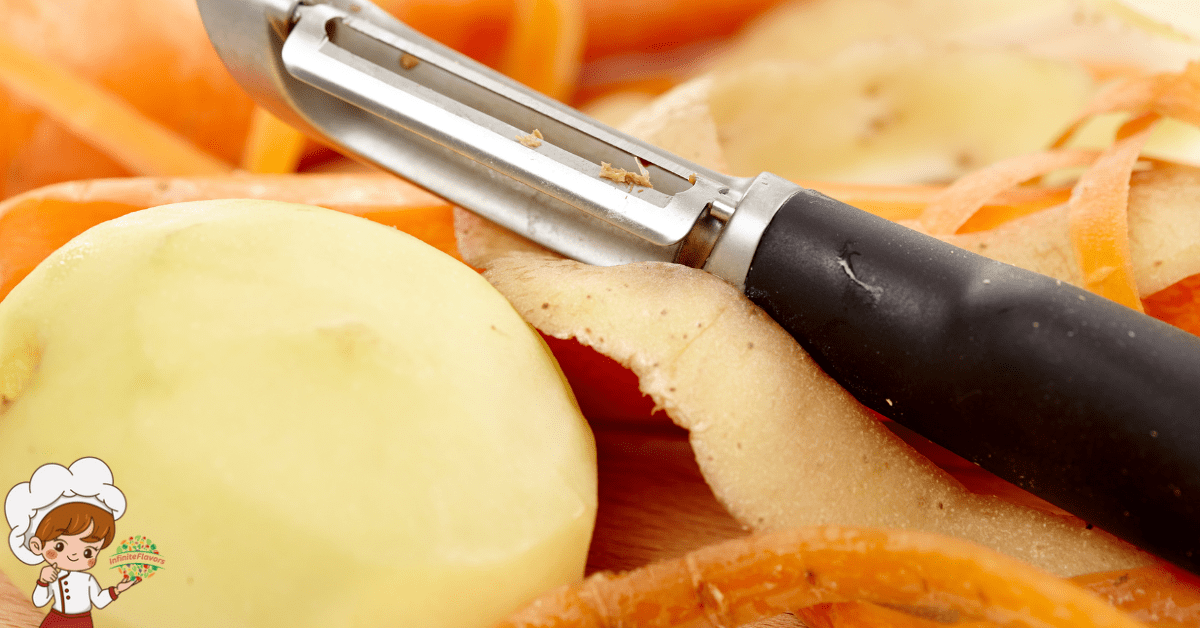Exciting Slow Cookers For Crafting Homemade Broths

Using Slow Cookers For Crafting Homemade Broths makes the process effortless and enjoyable. You can layer quality bones, seasonal veggies, and fresh herbs in your cooker, allowing flavors to meld over time. With minimal supervision, you’ll extract rich, nutritious flavors without the daily hassle of cooking. Choose the right size and type of slow cooker based on your needs for batch sizes. Following a simple process, you can create versatile broths that elevate your soups and sauces. And as you experiment with various ingredients, you’ll discover even more ways to enhance your broth game.
Benefits of Slow Cookers
Using a slow cooker makes it easy to create rich, flavorful broths with minimal effort. With just a few ingredients, you can set your slow cooker and let it work its magic. This time-saving convenience means you can spend more time focusing on your day while your broth simmers away, developing deep flavors and nutrients.
One of the biggest advantages of using a slow cooker is the ability to prepare large batches of broth without constant supervision. You can toss in your ingredients in the morning, go about your day, and return to a delicious, homemade broth in the evening. This not only saves you time but also allows you to enjoy nutritious meals without the hassle of daily cooking.
Moreover, slow cooking enhances the nutritional value of your broths. The low and slow method extracts flavors and nutrients from the bones and vegetables, creating a broth that’s rich in vitamins and minerals. You’re not just making a base for soups; you’re crafting a healthful addition to your meals that can boost your immune system and nourish your body.
In today’s fast-paced world, having a slow cooker in your kitchen can transform the way you approach meal preparation. You’ll find that making broth becomes a simple, enjoyable process that leads to nutritious meals your family will love. So, embrace the convenience of a slow cooker and elevate your cooking game with homemade broths.
Essential Ingredients for Broths
When you’re making broth, choosing the right ingredients is key. You’ll want to contemplate your meat choices, the vegetables you add, and those flavor enhancers that really bring it all together. Let’s explore what works best for creating a rich, delicious broth in your slow cooker.
Meat Choices
Choosing the right meat is essential for crafting a rich, flavorful broth that enhances any dish. Start by considering beef options like shank, short ribs, or oxtail for a hearty base. These cuts simmer beautifully, releasing deep flavors and gelatin that create a luscious texture. If you prefer poultry types, you can’t go wrong with chicken backs, wings, or even a leftover carcass. They provide a lighter broth that’s perfect for soups and sauces.
For those who enjoy the ocean’s bounty, seafood choices such as shrimp shells or fish heads can yield a delicate, nuanced broth. Just be sure to add these ingredients towards the end of cooking to prevent them from becoming too fishy. If you’re feeling adventurous, game meats like venison or duck can introduce unique flavors that elevate your broth.
Lastly, if you’re leaning towards a vegetarian alternative, consider using mushrooms or legumes for depth. While not meat, they can provide a savory umami kick that mimics traditional broths. Whatever your choice, remember that the quality of your meat is key to achieving that signature depth of flavor. Happy cooking!
Vegetable Additions
Incorporating a variety of vegetables can transform your broth, adding layers of flavor and nutrition that elevate any dish. Start by choosing seasonal vegetables, as they not only taste better but also provide the freshest nutrients. Think of carrots, celery, and onions as your foundational trio. These root vegetables offer sweetness and depth, creating a rich base for your broth.
You can also experiment with other seasonal additions like leeks, garlic, and even mushrooms, which can introduce umami notes to your concoction. Don’t shy away from leafy greens either; spinach or kale can be tossed in towards the end of cooking for added vitamins and a pop of color.
Flavor Enhancers
To elevate your broth’s flavor, consider adding key enhancers like herbs, spices, and salt that complement your vegetable base. Start with umami boosters like dried mushrooms, miso paste, or soy sauce. These ingredients deepen the savory notes, making your broth richer and more satisfying.
Next, explore various spice combinations to create a unique flavor profile. Bay leaves, thyme, and rosemary work wonders together, while a touch of crushed red pepper can add warmth. Don’t shy away from experimenting; each spice offers a different dimension to your broth.
Salt is essential, but remember to add it gradually. Too much can overpower your broth, so taste as you go. If you’re looking for a hint of sweetness, consider adding a splash of apple cider vinegar or a few whole cloves.
Choosing the Right Slow Cooker
When selecting a slow cooker for homemade broths, consider the size and features that best fit your cooking habits. Slow cooker sizes typically range from 1.5 to 8 quarts, so think about how much broth you usually make. If you’re cooking for a large family or batch cooking for the week, a larger model (6-8 quarts) will serve you well. For smaller households or occasional broth-making, a 3-4 quart cooker might be sufficient.
Next, evaluate the slow cooker types available. You’ll find traditional models, programmable options, and multi-cookers. Traditional slow cookers are straightforward and perfect for those who want a simple, no-fuss approach. Programmable slow cookers allow you to set cooking times and temperatures, giving you more control over the broth-making process. If you’re looking for versatility, multi-cookers combine slow cooking with other functions like pressure cooking and sautéing, making them great for those who want to experiment.
Additionally, consider features like removable inserts for easy cleaning, lid locks to prevent spills, and temperature settings that suit your needs. A well-designed slow cooker can enhance your broth-making experience, allowing you to create rich, flavorful broths with minimal effort.
Ultimately, the right slow cooker for you will depend on your cooking style, frequency, and preferences. Take the time to explore different options, and you’ll soon find the perfect companion for your homemade broth adventures.
Preparing Ingredients for Broth
When preparing ingredients for broth, you’ll want to focus on choosing quality ingredients that enhance the flavor. Properly prepping your vegetables is just as important, as it can greatly impact the final taste. Let’s explore how to select and prepare your ingredients effectively.
Choosing Quality Ingredients
Choosing quality ingredients is essential for creating a rich and flavorful broth that enhances your dishes. Start by selecting organic produce whenever possible. Organic vegetables and herbs not only taste better but are also free from harmful pesticides and chemicals. This choice guarantees that your broth is not just delicious but also healthy.
Next, consider sustainable sourcing for your meat or bones. Look for local farms or suppliers committed to ethical practices. Grass-fed beef, free-range chicken, and wild-caught fish provide superior flavor and nutrition. By choosing sustainably sourced ingredients, you’re not only elevating your broth but also supporting responsible agriculture.
Don’t forget about spices and seasonings. Opt for fresh herbs and whole spices rather than dried ones. Fresh ingredients infuse your broth with a vibrant taste that dried options can’t match. When you gather your ingredients, inspect them for quality—look for vibrant colors, firm textures, and a fresh aroma.
Proper Vegetable Preparation
Properly preparing your vegetables can greatly enhance the flavor and depth of your homemade broth. Start by selecting fresh, quality vegetables—onions, carrots, and celery are classics. Use effective vegetable chopping techniques to guarantee even cooking and maximum flavor release. For instance, chop onions finely to allow their natural sweetness to infuse your broth, while larger chunks of carrots and celery can add texture.
When you’re ready to combine your ingredients, consider your flavor extraction methods. Sautéing your chopped vegetables in a bit of oil before adding them to the slow cooker can caramelize their sugars, intensifying the broth’s flavor. You can also roast them in the oven to develop even more complexity.
Don’t forget to include herbs and spices! Adding them towards the end of the cooking process can preserve their vibrant flavors. Remember, the way you prepare your vegetables directly impacts the overall taste of your broth, so take your time with this step. By employing these techniques, you’ll create a rich, flavorful base that’ll elevate any dish you use it in.
Step-by-Step Broth-Making Process
To create a rich and flavorful broth, start by gathering quality ingredients like bones, vegetables, and herbs. Choose bones with a good amount of marrow for depth and richness. Common options include beef shank, chicken carcasses, or pork bones. Next, select fresh vegetables such as onions, carrots, and celery. You can also toss in garlic, leeks, and herbs like thyme, parsley, or bay leaves to elevate the flavor.
Once you have your ingredients, it’s time to prepare your slow cooker. Place the bones at the bottom, then layer your chopped vegetables over them. Don’t forget to add a tablespoon of apple cider vinegar; it helps draw out nutrients from the bones, enhancing the broth’s health benefits. Fill the slow cooker with cold water until everything’s just submerged.
Now, set your slow cooker to low and cover it. Broth myths often claim that simmering for just a couple of hours is enough, but a longer cooking time allows flavors to develop fully. Let it cook for at least 12 hours. You can even let it go for up to 24 hours for a more concentrated flavor.
Once the cooking time is up, strain the broth through a fine mesh sieve to remove solids. Store your homemade broth in jars or containers, ready for soups, sauces, or sipping. Enjoy the numerous broth benefits, from supporting gut health to providing essential nutrients, knowing you’ve crafted something truly nourishing.
Cooking Times for Different Broths
When you’re making broths, cooking times can vary considerably depending on the ingredients. Bone broth typically requires a longer simmer to extract all those rich flavors and nutrients, while vegetable broth cooks up quicker. Knowing these timings will help you create the perfect batch every time.
Bone Broth Timing
Cooking times for different types of bone broth can vary considerably, so it’s important to know the right duration for each to achieve the best flavor and nutrition. When you’re making beef bone broth, aim for 24 to 48 hours in your slow cooker. This extended cooking time extracts maximum collagen and nutrients, enhancing the bone broth benefits. For chicken bone broth, you can reduce the time to about 12 to 24 hours, as chicken bones are more porous and release their goodness quicker.
If you’re using pork bones, a cooking time of 12 to 24 hours will suffice, while fish bone broth needs the least time—around 6 to 12 hours—because fish bones break down more rapidly.
Timing tips are essential here: start with a longer cooking time, and you can always check the flavor and texture. If it’s not rich enough, let it simmer longer. Remember, the longer the simmer, the more nutrients and flavors you’ll extract. So, keep these timings in mind, and you’ll create delicious, nutrient-packed bone broth every time!
Vegetable Broth Duration
While bone broths require longer simmering times to extract their full flavors and nutrients, vegetable broth can be made in a much shorter duration, typically ranging from 1 to 3 hours in a slow cooker. This makes it a perfect option for those days when you need a quick, nutritious base for soups or sauces.
To achieve the best flavor, you should chop a variety of vegetables like onions, carrots, and celery, along with herbs and spices. Add these to your slow cooker with water, then set it to cook. If you prefer a lighter broth, 1 to 2 hours is usually sufficient; for a richer flavor, consider letting it simmer for the full 3 hours.
Keep in mind that the longer you cook your vegetable broth, the more pronounced the flavors will become. However, it’s important not to overdo it, as cooking for too long can lead to bitterness. After the broth duration is complete, strain out the solids, and you’ll have a delicious homemade vegetable broth ready to enhance your meals. Enjoy experimenting with different vegetable combinations to find your perfect blend!
Flavor Enhancers and Herbs
Enhancing the flavor of your homemade broths starts with the right combination of herbs and spices. Choosing the right herb combinations can elevate your broth from bland to delicious. For a classic vegetable broth, try mixing thyme, bay leaves, and parsley. These herbs create a balanced flavor profile that complements various dishes. If you’re aiming for a more robust taste, consider adding rosemary and sage. These herbs bring depth and warmth, making your broth perfect for hearty soups.
Don’t forget about garlic and onion! They’re essential for building a strong foundation of flavor. You can sauté them briefly before adding them to your slow cooker to bring out their natural sweetness. For an Asian-inspired broth, experiment with ginger, lemongrass, and cilantro. These ingredients will give your broth a fresh, vibrant flavor profile that pairs well with noodles or rice.
If you want to add a little kick, try including crushed red pepper flakes or a dash of soy sauce. Just be sure to taste as you go, adjusting the seasoning to suit your palate. Remember that fresh herbs usually provide a brighter flavor, while dried herbs can offer a more concentrated taste.
Lastly, don’t underestimate the power of acidity. A splash of vinegar or a squeeze of lemon can brighten your broth and enhance its overall flavor. With these tips, you’ll create homemade broths that are rich, savory, and bursting with flavor.
Storing and Freezing Broths
Once you’ve crafted a flavorful broth, knowing how to store and freeze it properly guarantees you can enjoy it later without sacrificing taste or quality. Start by letting your broth cool to room temperature. This prevents condensation in your storage containers, which can dilute the flavor.
For broth storage, use airtight containers or freezer-safe bags. If you’re using bags, lay them flat in the freezer to save space and make stacking easier. Make sure to leave some headspace in the containers, as the broth will expand when frozen. Label each container with the date and type of broth, so you can easily identify them later.
When it comes to freezing techniques, consider portioning your broth into smaller servings. This way, you can thaw just what you need for future recipes without having to defrost the entire batch. Ice cube trays work great for this! Once the broth is frozen, transfer the cubes to a freezer bag for efficient storage.
Broth can typically be frozen for up to six months. After that, while it might still be safe to use, the flavor may decline. When you’re ready to use your frozen broth, simply thaw it in the refrigerator overnight or heat it gently in a saucepan. Avoid using a microwave for this, as it can create uneven heating. With these methods, you can enjoy your homemade broth anytime, ensuring it’s just as delicious as when you first made it.
Using Broths in Recipes
Using homemade broth in recipes not only elevates the flavor but also adds depth and richness to your dishes. Whether you’re making soups, stews, risottos, or sauces, incorporating your homemade broth can transform a simple meal into something extraordinary. When you use broth as a base, you’re not just adding liquid; you’re infusing your food with layers of savory goodness.
If you find yourself in a pinch and don’t have your homemade broth on hand, don’t worry! There are plenty of broth substitutions that can work in a pinch. Store-bought broths or stock can serve as a decent alternative, but keep in mind they often contain preservatives or excess sodium. You can also consider using water infused with herbs or spices to mimic some flavors of your homemade version.
When it comes to broth applications, think beyond just soups. Use your broth as a cooking liquid for grains like rice or quinoa to enhance their flavor. You can also deglaze pans after sautéing vegetables or proteins, using broth to lift those caramelized bits off the bottom for a delicious sauce. In marinades, adding broth can help tenderize meats while imparting flavor.
Common Mistakes to Avoid
Avoiding common mistakes can make all the difference in achieving a rich and flavorful homemade broth. One of the most significant pitfalls is overcooking issues. While slow cookers are designed for long cooking times, you still need to monitor the duration. If you let your broth simmer for too long, it can turn bitter or overly concentrated. Stick to the recommended cooking times based on your recipe, usually around 8 to 12 hours on low heat, depending on the ingredients.
Another common mistake involves the ingredient ratios. It’s crucial to balance your ingredients to get the best flavor. If you add too many bones or not enough vegetables, you might end up with a broth that’s too greasy or lacking depth. A general guideline is to use about 1 pound of bones for every 4 cups of water, and don’t forget to include aromatics like onions, garlic, and herbs for added flavor.
Additionally, be mindful of your seasoning. Adding salt too early can lead to an overly salty broth, especially as the liquid reduces during cooking. Instead, season your broth towards the end of the cooking process to give you better control over the final taste.
Cleaning Your Slow Cooker
Cleaning your slow cooker after making broth is essential to maintain its longevity and guarantee your next culinary creation tastes just as delicious. If you don’t clean it properly, leftover bits can lead to off-flavors or even impact the performance of your appliance. Start by unplugging your slow cooker and letting it cool down. Once it’s cool, remove the inner pot, which is usually dishwasher-safe. If you prefer hand washing, use warm, soapy water and a non-abrasive sponge to scrub away any residue.
For effective cleaning, pay special attention to the lid and the heating element. The lid can accumulate grease and condensation, so make sure to wipe it down thoroughly. If you notice any stubborn stains, a mixture of baking soda and water can work wonders. Just apply it to the affected area, let it sit for a few minutes, and then scrub gently.
Creative Broth Variations
Exploring creative broth variations can elevate your dishes and introduce exciting flavors to your meals. Instead of sticking with a basic broth, why not experiment with unique ingredients? One fantastic option is spicy miso broth. By adding miso paste along with some chili flakes, you’ll create a rich, umami-packed base that can transform soups and stews. Just toss in your favorite vegetables and proteins, and let your slow cooker work its magic.
If you’re in the mood for something a bit sweeter and creamier, consider a creamy coconut broth. Combine coconut milk with vegetable or chicken stock, and add aromatics like ginger, garlic, and lemongrass. This tropical twist is perfect for curries or noodle dishes. Don’t forget to season with lime juice and fresh herbs to brighten up the flavors!
You can also blend these ideas to create a spicy coconut miso broth, combining the best of both worlds. Adjust the spice levels to suit your taste; maybe add some sliced jalapeños or a dash of sriracha for extra kick.
Frequently Asked Questions: Slow Cookers For Crafting Homemade Broths
Can I Use Frozen Ingredients in My Slow Cooker Broth?
Yes, you can use frozen vegetables in your slow cooker broth. They’ll still add plenty of flavor, but keep in mind that cooking times might need slight adjustments for the best broth flavor.
How Long Can I Store Homemade Broth in the Fridge?
You can store homemade broth in the fridge for about 3 to 4 days. For better broth shelf life, consider freezing it in portions, which can last for several months and maintain its flavor.
Are There Any Health Benefits to Homemade Broth?
Yes, homemade broth offers numerous health benefits. You’ll enjoy nutritional advantages, like vitamins and minerals, while enhancing your digestive health. It’s a comforting way to nourish your body and support overall wellness.
Can I Make Broth Without Meat?
Yes, you can make broth without meat! Simply use a variety of vegetables, herbs, and spices. This vegetable broth not only adds flavor enhancement but also provides a delicious, nutritious base for soups and stews.
What Are Some Common Dietary Restrictions for Broth Ingredients?
When considering dietary restrictions for broth ingredients, think about vegan alternatives like mushrooms or seaweed. Also, low sodium options are essential for those managing blood pressure. Always check labels to verify compliance with specific diets.
Conclusion
Using a slow cooker to craft homemade broths is a game-changer for your kitchen. Not only does it simplify the process, but it also enhances the flavors of your dishes. With a few essential ingredients and some patience, you can create rich, nourishing broths that elevate your recipes. Remember to experiment with different variations and avoid common mistakes for the best results. Embrace the convenience of slow cooking, and let your creativity shine in every bowl!








